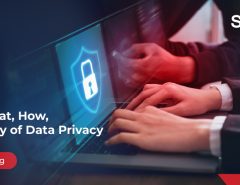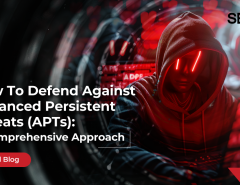Technology continuously evolves to provide greater and more powerful features. At the same time, newer threats are getting uncovered with every advancement in technology. More modern devices present fresher avenues and endpoints that can be used for hacking and making a breach. New technology provides new gaps and loopholes that can be used to breach into an organization’s networks and systems. Advanced technical solutions can now generate and create different kinds of data (such as customer behavior etc.) which provide new incentives for a hacker to breach and acquire that data.
It seems that there can never be a time when a perfect, impenetrable system will be created and deployed for long before a vulnerable node is spotted by hackers. However, there are certain measures that organizations can take to protect and secure the fragile network, data and resources which form the backbone of operations in this age of information.
1. Include security in system architecture– Whether we talk about enterprise or system architecture, their safety must be a primary requirement. The system must be designed with integrated security rather than it being added as a patch later. While building the system, safe coding practices must be followed and security must be built into the business processes. A separate role for information security officer must be created to take charge of cyber security of the organization. Adding security aspects after the enterprise architecture or system is designed and implemented, will make the security solution complex.
2. Strong password policy –Brute force attacks are a popular form of cyber attack. In such an attack, multiple combinations of characters are attempted as a password to break into the system. Using regular words or names as password makes the system vulnerable as these are relatively easy to guess. Having a complex combination of alphanumeric and special characters makes it difficult to break using brute force attack. Similarly, the longer the password, the better the security that it provides. In fact, each added character doubles the brute force attempts required to break in. Disabling the login id, after a predefined number of unsuccessful attempts ensures that brute force hackers do not get a chance to try all possible combinations. Organizations must implement a strong password policy as this is the first line of defense against all hacks.
3. Strong Internet protection suite
a) Firewall – Monitoring of web-traffic or even traffic between 2 internal networks allows you to detect and control abnormal and harmful It can help you block all the traffic that is unnecessary for business needs. An active firewall policy not only limits the unbeneficial traffic but it also stops the traffic moving from all malicious sites thereby protecting the network and enterprise data. While there are many firewall solutions out there, select the one that suits your organization’s need. Here the depth and breadth of the protection required will form the key parameters for firewall selection.
b) Powerful antivirus– This one is a no brainer. Organizations must select the best antivirus they can afford, even if it costs a little extra. Various parameters such as the geographical spread of work force, the movement of people within and outside the network (such as remote working), hosting environment (in house or cloud or third party hosting) will form the key parameters to select the optimum antivirus software for your particular needs. While most vendors will cover a wide variety of viruses, malware, ransomware protection, choose the software based on the depth and speed of response. For example, for a mission critical system such as healthcare, you need a swift response time but for high data volume business, you need a solution that is ironclad.
4. Secure mobile devices (laptops, smartphones). IT environment today has changed radically. Just a few years ago people used only desktops which stayed at one place, and all desktops had the same configuration across the organization. However, today the workforce is mobile, and the BYOD (bring your own device) culture is gaining momentum. Further, the smart phones and tablets are also getting integrated into the corporate These devices come in as many configurations as brands and models being sold in the market. Supporting these many varieties of devices becomes a challenge from a security perspective. Organizations must be cognizant of the mobility needs of their workforce and must consider security implications while providing their employees with the option of using mobile devices. There are plenty of mobile device management (MDM) solutions that cater to this requirement. Moreover, the organization must limit the number of devices that are allowed to access the enterprise network.
5. Secure all end points.With increasing number of mobile devices, the number of endpoints that can be used to access or hack into company data has increased Each device carries at least 3 to 4 endpoints each. Due to a variety of device models and configurations, each end point is different from the others. Irrespective of the differences, each end point must be secured. A comprehensive end point management software has become a mandatory requirement for today’s mobile, geographically spread and high productivity work force.
Security solutions are not a ‘fit it and forget it’ solutions. Security is an ongoing practice and secure methods must be carried out day in and day out. The security practices must be imbibed in the culture of the organization. Any organization that fails to understand this fundamental aspect of security is bound to be vulnerable to an attack. There are many security tools such as Seqrite End Point Security and Gateway solutions that ensure that there are no breaches on the network of the enterprise.
Seqrite helps businesses simplify IT security and maximize business performance. To know more about our products and services visit our website or




